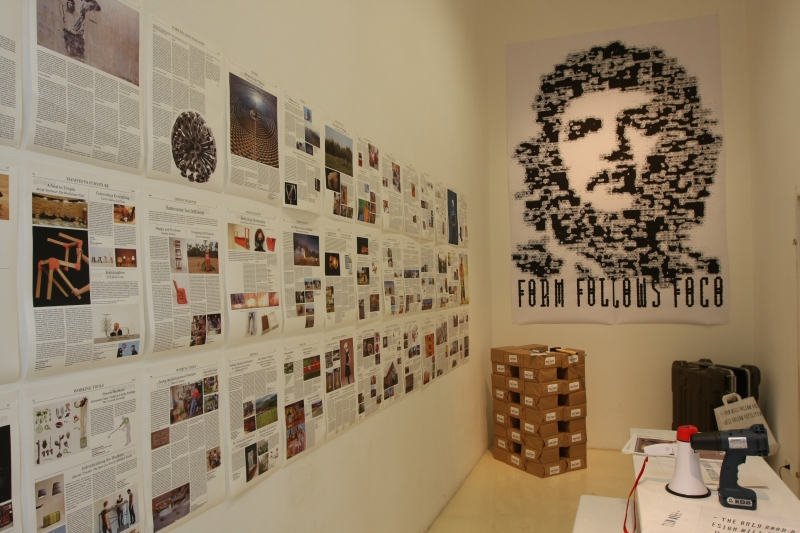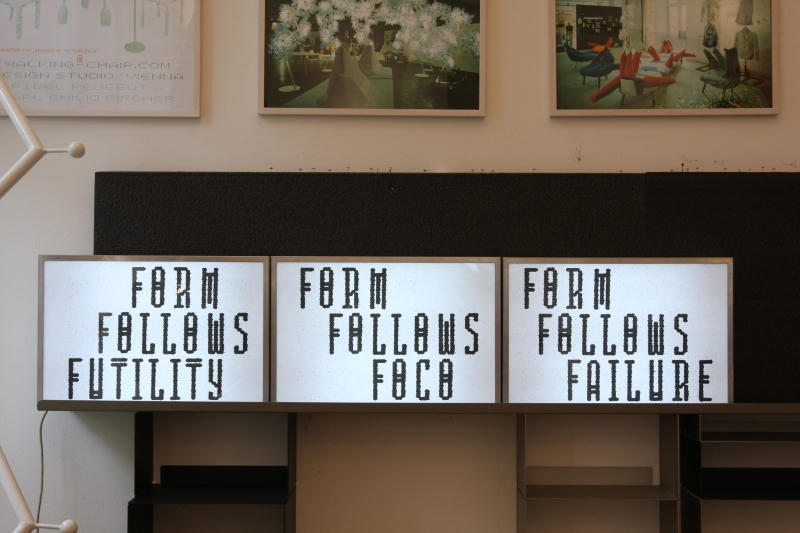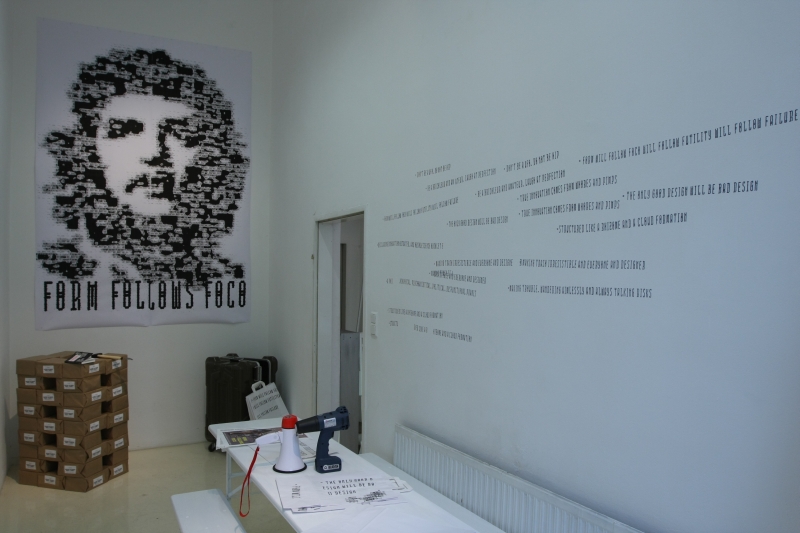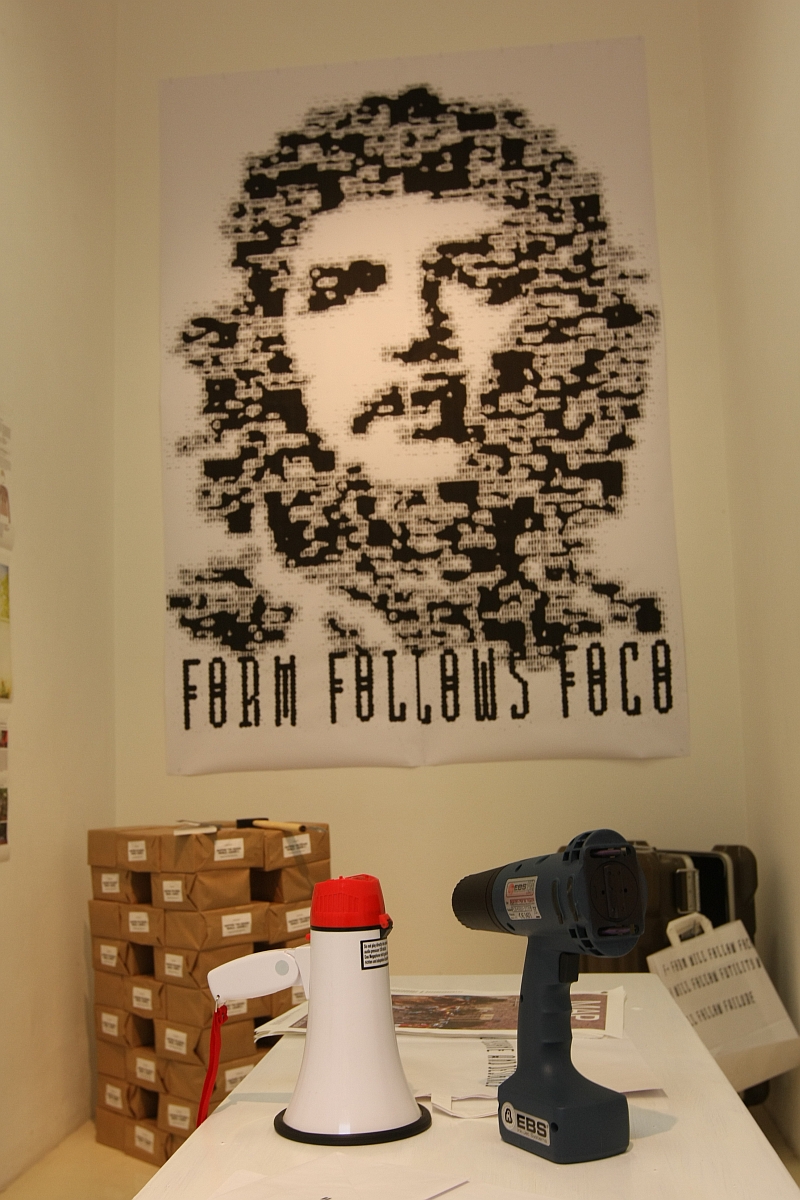In our post from the exhibition Made in Slums – Mathare Nairobi at the Triennale Design Museum Milan we referred to the Belgian author and curator Max Borka and his theory that the unique accent of Berlin design is largely a result of the near continual crisis the city has had to endure over the decades; a reality that has resulted in a very site specific response from designers and architects alike.
During Vienna Design Week 2013 Max Borka launched a new book that explores where such a vernacular design development could, should, take us.
And in doing so, and without every intending to or wanting to, places Made in Slums in a global context.
"Form Follows Foco. 100 Snapshots of Guerilla Survival Props" is the second publication in the context of Max Borka's "Mapping the Design World" project.
Initiated in 2012 Mapping the Design World is an attempt to catalogue/support/promote/encourage the myriad of social and critical design projects that have evolved in recent years, often in response to specific local conditions.
In 2012 the project's first publication showcased 100 examples of such social design projects, projects as varied as the Svalbard Global Seed Vault in Norway, Mohammed Bah Abba's Zeer/Pot-in-Pot electricity-free cooler system and the ever genial Mine Kafon by Massoud Hassani.
The hope of the Mapping the Design World protagonists is that if all the small scale, local projects can be understood in a unitary global context then their combined effect can achieve real lasting change for the good of society as a whole, basing its logic on Foco: a theory championed by Che Guevara which argues that the combined effect of small guerilla groups acting locally can lead to a large scale revolution.
"Form Follows Foco" in effect provides a theoretical background as to how such could, potentially, be realised, and explains why such is desirable, honourable and beneficial.

Presented as a 100 short-ish notes "Form Follows Foco" combines Max Borka's considered conclusions from his close observations of contemporary design and global culture with the views of design/cultural theorists of various ilks in an easy to read and even easier to understand text aimed at professionals and lays alike. A work that at times speaks directly to designers, at times directly to the wider community. So, us.
Max Borka's principle targets may seem obvious, but they are also unquestionably correct: obsolescence, fashion, consumerism, vanity, over production, endless new design magazines, design fairs....
The harshest criticism however is reserved to denounce design's subordination to capitalism and the unilateral demands of the global market.
"Problems only started when marketing claimed design's fatherhood", he writes in Snapshot 14, "scared off all competitors, and turned it into a dandy and a prig, afflicted with tunnel vision, and producing nothing but commodities, corporate junk, capitalist consumable..."
The result, according to Max, is that the notion of design has been reduced to "... little more than a lubricant that helps to realize a scarcely hidden agenda: "Sell whatever to whoever in whatever way": Pretending to be the Tool of Tools - brandishing truisms such as "Form follows Function" - the real status of design most often doesn't exceed that of a useful fool - while designers have been degraded to entertainers"
Sentiments with which it is really hard to disagree with, and which of course brings us back to the 2012 symposium "Warum Gestalten ?" at the HfBK Hamburg and for all to German Design Council CEO Andrej Kupetz's position that industry's principle focus is product differentiation, or offering us just enough colours and materials so that we believe we have successfully straddled the divide between individualism and belonging to an identifiable social group. In Snapshot 10 Max Borka makes a similar point when he refers to America author Thomas Frank's concept of "market populism" in which "... people's true desires are expressed and fulfilled through the marketplace". Or Snapshot 40s position that, "Today's design is meant to keep us dreaming instead of becoming our dreams"
Points which of course also echo Christoph Schäfer's theory of "Royal Participation" whereby we're told we are being given a choice, but we're not really. We're just being given a larger board on which to prove our pawn like nature and our complete dependence on global brands.
Such thinking is naturally not new, nor is Max Borka the first to tackle such, he himself references William Morris, and for our part when reading many of his arguments we are reminded a lot of Enzo Mari and his complete disdain for the market and, well just about everything.
What however is new, or at least rarely articulated, is Max Borka's use of such arguments as a springboard to argue that design can be different, design can be more, design can be used for social good. If designers can be freed from the fangs of the market.
Consequently the majority of "Form Follows Foco" looks forward. Tries to show us that there is a path out of the unsightly forest that has grown up around us. Tall and smothering as it is.

For Max Borka this way forward is, as already implied, largely through the combined effect of the small scale social design projects championed by the Mapping the Design World project.
Yet much as we like Max's idea of a global community of small projects growing up to challenge the norm. We fear they won't.
At least not globally. And not in our western world.
We completely agree with Max's position that the search for "one big solution" blinds society to the possibilities presented by the myriad of small solutions. And that the small solutions are more often than not the optimal solution.
But for us the answer doesn't come from the solutions, but the acceptance by society of the solutions. And for that we are all far too selfish. Industry too dominant. At least, as we say, in our western society.
Away from Europe and America such might, can, be possible. As Made in Slums beautifully shows. And which Max, more or less, supports with Snapshot 82's position that "When communities are the main material, in developing countries, for instance, design will absorb and exploit the latest that technology can make available to it, but only when it can offer local answers to local needs, increasing local productivity and income, as well as self-reliance and democracy"
But if that drifts through too Europe? America? We don't think so. Happy as always to be proved wrong, but.......
Aside from the small scale projects, for Max a further way forward is through better eduction. "Not just design education but the whole education system need a total rethinking - providing anyone with the necessary social capital to become a designer" Views that tally very well with those expressed by Lucas Verweij when we spoke to him at DMY Berlin 2012. It must be those Benelux genes. Or at least what happens when those from the Benelux lands spend too much time in Berlin.
Elsewhere Max Borka coherently and convincingly discusses design's need to establish a memory, to move on from what he calls its current Alzheimer's Disease, the need to rediscover relevance over physical beauty, to become anthropological and to understand the community for whom one is designing.
One of Max Borka's more interesting positions is that design needs to become problem raising rather than problem solving, a position that obviously puts design in direct conflict with art, literature or music, mediums that have until now largely taken on the responsibility of holding a mirror up to society to confront it with the reality of its ills. But why shouldn't design join its near relatives? Why shouldn't design stop conforming and start provoking?
Or as Snapshot 75 asks "Can we not be political as designers? Can we still argue: "I'm not into politics" and stay neutral? No, we can't"
Buy that man a beer!

Form Follows Foco presents a brutal vision of the current reality. Yes, as it approaches you can't ignore its heavy philosophical lean to the left, but the impression presented is honest, uncontrived, considered and unashamed. And importantly it is a impression presented with constructive suggestions for how we can change the status quo.
And the status quo must change.
For only the very foolish, or biased, would argue against the fact that we need to fundamentally change the nature of our society if we are to have a sustainable global future where all can enjoy a meaningful and dignified existence.
Designers have an important role to play in facilitating such change.
Form Follows Foco doesn't say what should be done, but it is an entertaining and eloquently expressed contribution to the debate and a text that anyone who wants to be part of the change should read.
You wont agree with everything contained therein.
But in a way, that's the point.......
Max Borka "Form Follows Foco. 100 Snapshots of Guerilla Survival Props" is published by Walking Chair Design Studio/Gallery, Vienna and is available in all respectable bookshops or via www.walking-things.com
